Diving - The adventure continues!
More UK Diving - Later in 2017
Plymouth, June 2017
Plymouth is always good to visit.
I've come up from dives and surfaced to a sea as flat as a Pool table, I've seen cuttlefish on the deck of HMS Scylla and swum the length of the James Eagan Lane and back, marvelling at the cathedral like structure all around me. I've enjoyed the huge, deeper wreck of the Persier and the simple pleasures of the Breakwater fort.
This weekend was no different, but offered some new sites and sights.
10 of us arrived in different transport on the Friday, checking into our usual lodgings, the excellent Moorings Guesthouse where we made as welcome as we always are.
After a few beers and dinner at the nearby Waterfront pub, we adjourned for the night and then headed to the boat after a hearty full English the next morning.
We were on Venture this weekend and the first day we dived the old favourites, HMS Scylla and the James Eagan Lane.
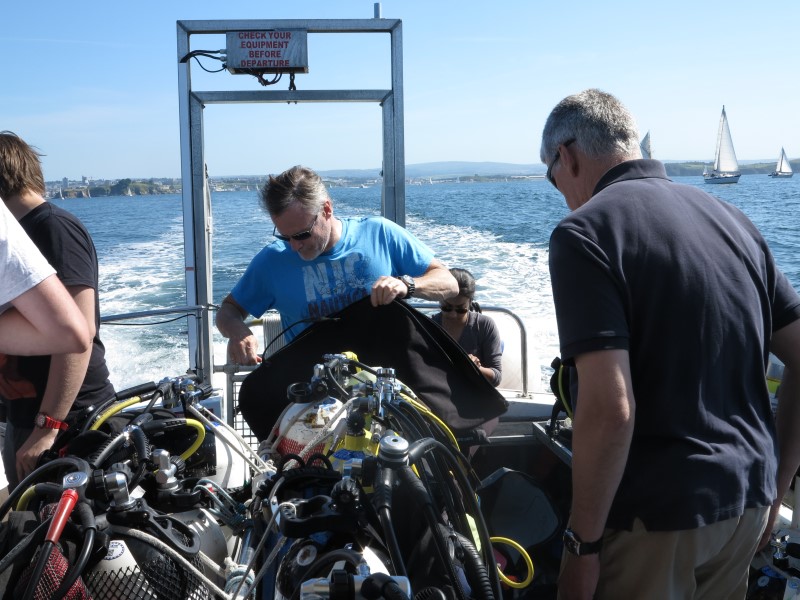
Preparing for the first dive
Vis was pretty good (5-10M, I'd guess), but my (and Paul Thompson's) first dive went awry from the start.
As I jumped in, my left foot felt odd. Having fairly new boots, I wondered if it was just water in them, but I'd glanced below the surface to see my fin slide off the boot and, frustratingly, slip into the depths only millimeters from my grasp!
Luckily the skipper had a spare pair of fins, so Paul and I were soon descending. I turned and checked he was OK and received and "OK" back and then, a couple of fin strokes later, spotted the top of the ship and dropped onto the hull, turning around to check on Paul.
He was nowhere to be seen! Believing I was on the bow of the Scylla I looked up expecting to see the bridge, but there was nothing there. Looking down there was a large hole and looking around, no sign of Paul.
After a few moments, I realised I was at the stern, looking down into the roofless Helicopter hanger, so, still not able to see Paul, I tried to launch my DSMB. It has a small cylinder and should fly to the surface, but the cylinder had lost its air and it went nowhere!
Oh well, I'd had a problem before with this, so I had a conventional DSMB too. I'd use that...No, it refused to fill despite dumping a huge amount of air into its opening.
At this point, I gave in and decided to ascend. As I did so, I spotted Ria and Julian on the shot doing a safety stop, so I joined them.
Back on the surface, Paul was looking frustrated and baffled. Seems he'd become entangled in the buoy line on the shot and, as soon as he'd given me the OK sign, found he couldn't descend any further.
We canned the dive by this point, a bit of a shame, as others had clearly enjoyed a good dive on the Frigate - which is now becoming more a reef, covered in life, than a shipwreck, always the intention - with no other divers on the wreck.
Pete, the skipper and his lady assistant, served up piping hot Pasties between dives and, remarkably, most got one before John returned for seconds!
The James Eagan Lane lies only a few hundred yards from the Scylla, so after around 90 minutes we were soon setting up for dive number 2.
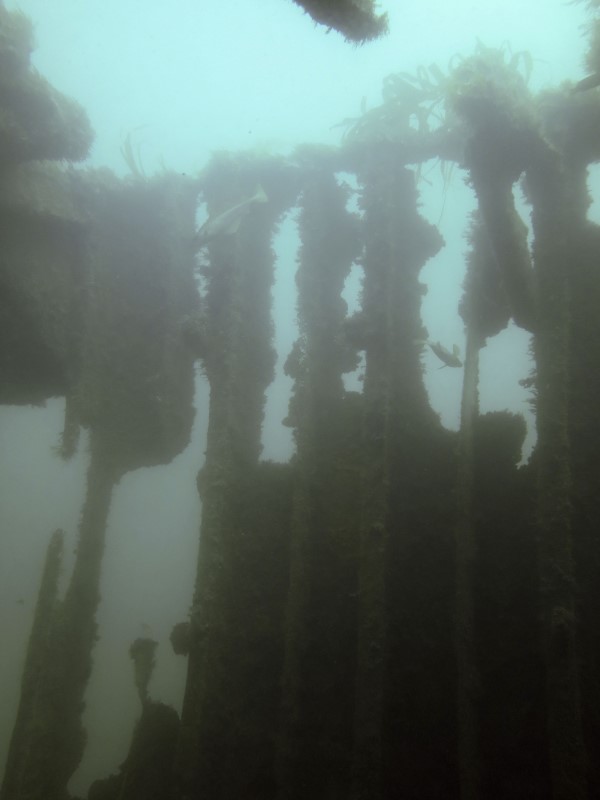
Skeleton of the JEL
Lying a little shallower than the Scylla, Paul and I soon reached the bow after descending the shot line and started to explore the wreck.
People with decades more diving experience than me recount stories of diving it as an almost intact hull, but part of the charm of the James Eagan Lane is undoubtedly the way the light falls through the skeletal structure now.
You could easily spend an hour within 20 yards of the bow, but as Paul was new to the JEL, I led him along the wreck, exploring the full length of the main part and then turning back, with just enough gas to reach the shot line and surface again.
With good vis, we had a chance to explore some of the machinery and cargo still lying in the wreck and get a good look at the huge number of fish, small and large, that shelter in the wreck.
Everyone seemed to have enjoyed their experience on the JEL (As most always do) and we returned to Plymouth, in glorious sunshine, happy even spotting a Sun Fish basking on the surface on the way!
Our tanks were unloaded and left with Sound Diver to fill overnight and we returned to the Moorings and quickly adjourned to the Waterfront for a couple of post-dive drinks in the glorious sunshine we had all weekend.
We booked a table at the very good curry house in the Barbican, the Himalayan Spice, and after everyone had showered and changed headed down there where we enjoyed a great curry and then returned to a good night's sleep ahead of our trip out to the Eddystone Lighthouse the following morning.
Geoff, who's dived for many more years than most of us (having started as a mere boy, I hasten to add! ;) ), remarked that it's rare to get weather good enough to allow diving around the exposed lighthouse, so we were all, I think, looking forward to a rare opportunity.
The journey out took around 90 minutes, but was pretty uneventful, with a calm sea and southerly, but very light, winds forecast.
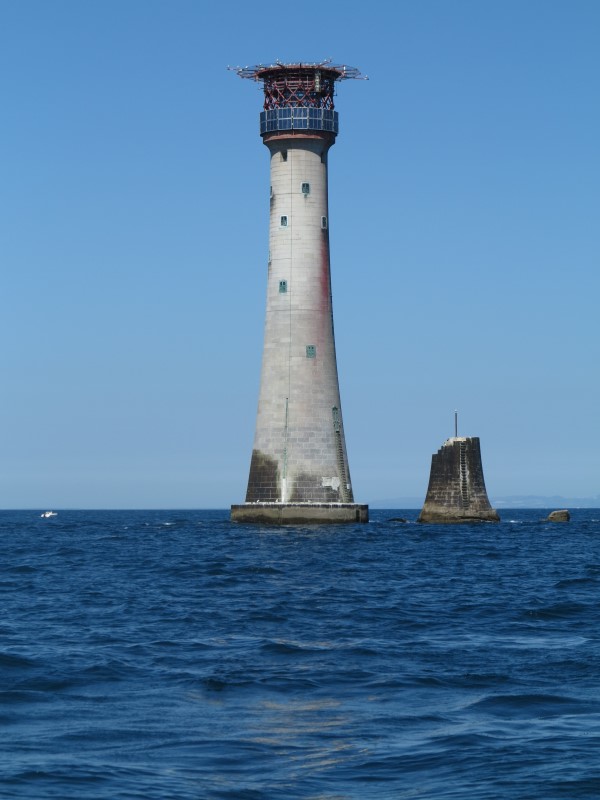
Eddystone, old and new
From a personal point of view, I found the dive a little disappointing (And I don't think I was alone). We dived reasonably deep down the reef, to around 35M, but, whilst there were some fish to be seen (and many jellyfish), it wasn't the abundance I'd imagined and the landscape was mainly big rocks.
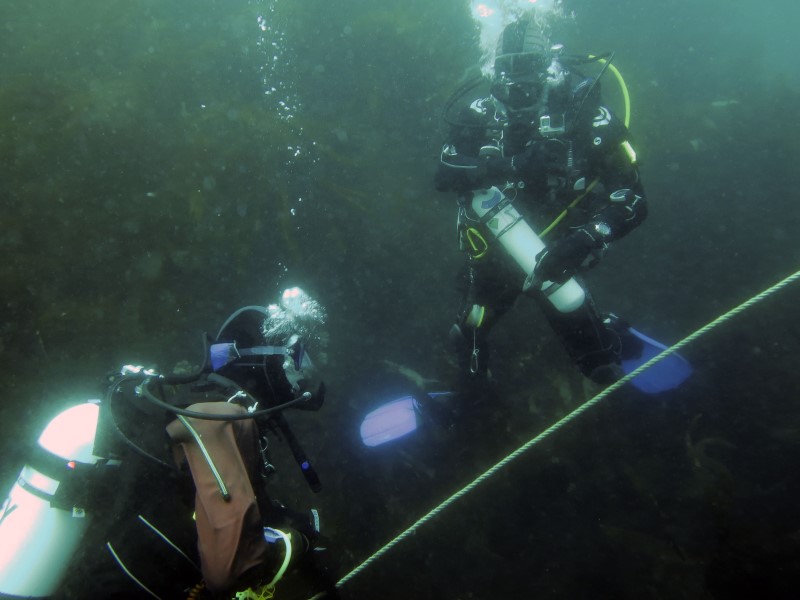
Julian and John on the Eddystone
Maybe we should have stayed shallower, but the vis was remarkably good (A comfortable 10+M) and we did spot a Ling, an eel like fish with a fish like tail, which I couldn't recall ever seeing before.
John (he and Julian and I dived as a 3 as Louise wasn't feeling well on the Sunday) and I completed a planned deco dive, counting towards our Advanced Diver training, but it wasn't a site I'd rush back to, if I'm honest, although it was quite interesting to visit the site of the famous lighthouse, with the remains of an earlier one standing next to the, now automated, modern one.
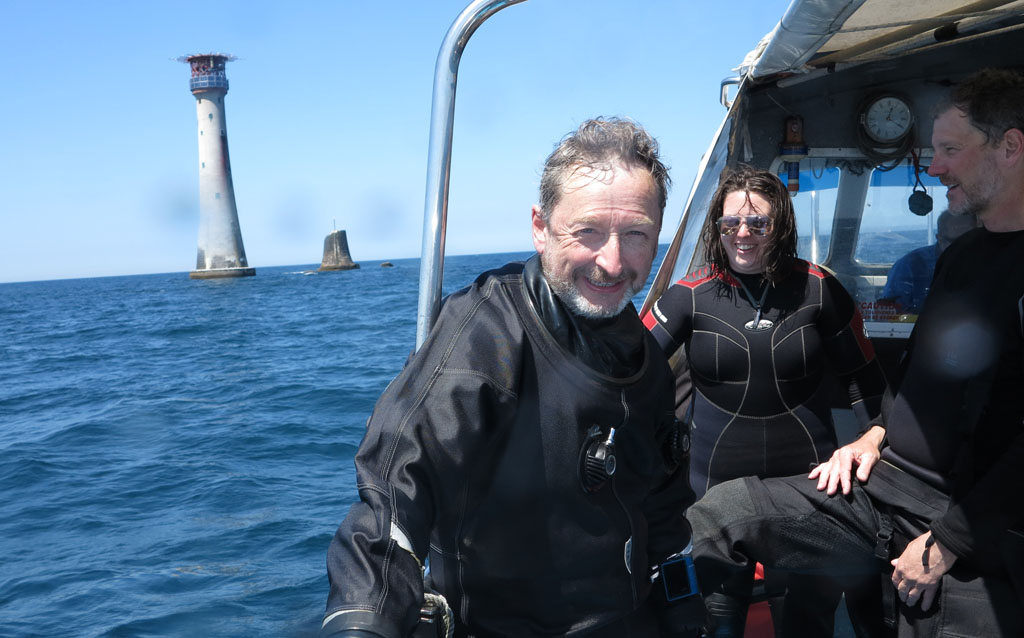
Me, Emma and Cameron, post Eddystone dive
The wind had unexpectedly picked up a little, so we were quite happy to head back into the shelter of the land to dive the Glen Strathallen as our final dive.
This wreck has little left to explore, except the main boiler (in which lives at least one large Conger Eel). On the positive side, it's shallow and exploring around the wrecksite allows you to potter in and out of schools of Wrasse and Bib and find Cuttlefish, Jellyfish and Lobsters lurking.
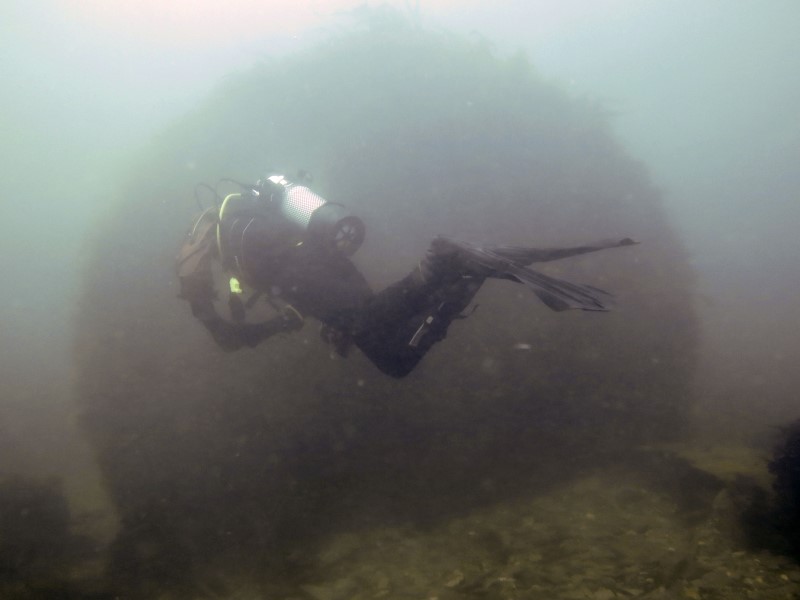
John on the boiler of the Glen Strathallen
In many ways, the gentle meander was the ideal final dive of the weekend and we managed to get back on the road by around 4:30 and get home by around 8, which wasn't too bad really.
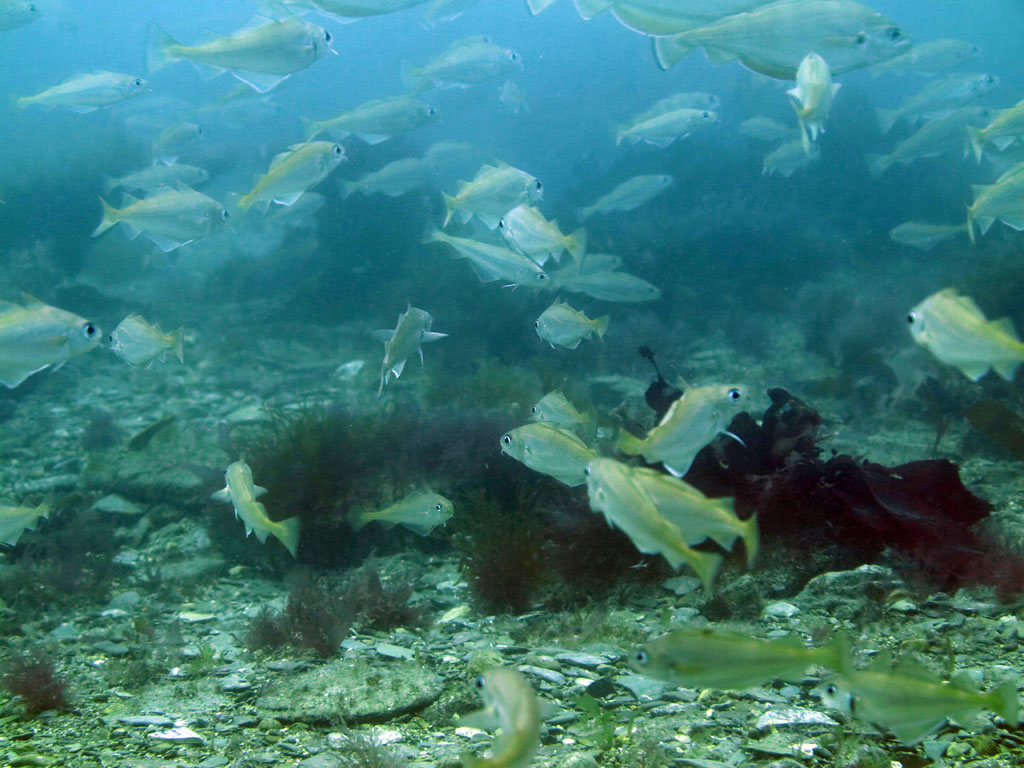
Plenty of life on the Glen Strathallen
Once again, I think everyone (Julian, Geoff, Ria, Louise - despite not feeling so well on Sunday, Paul, Emma and Dave, John and Myself) had had an enjoyable trip to Plymouth.
The Eddystone had been worth visiting, almost just to say you'd been there, and everyone had enjoyed the other, familiar for some, new to others, sites.
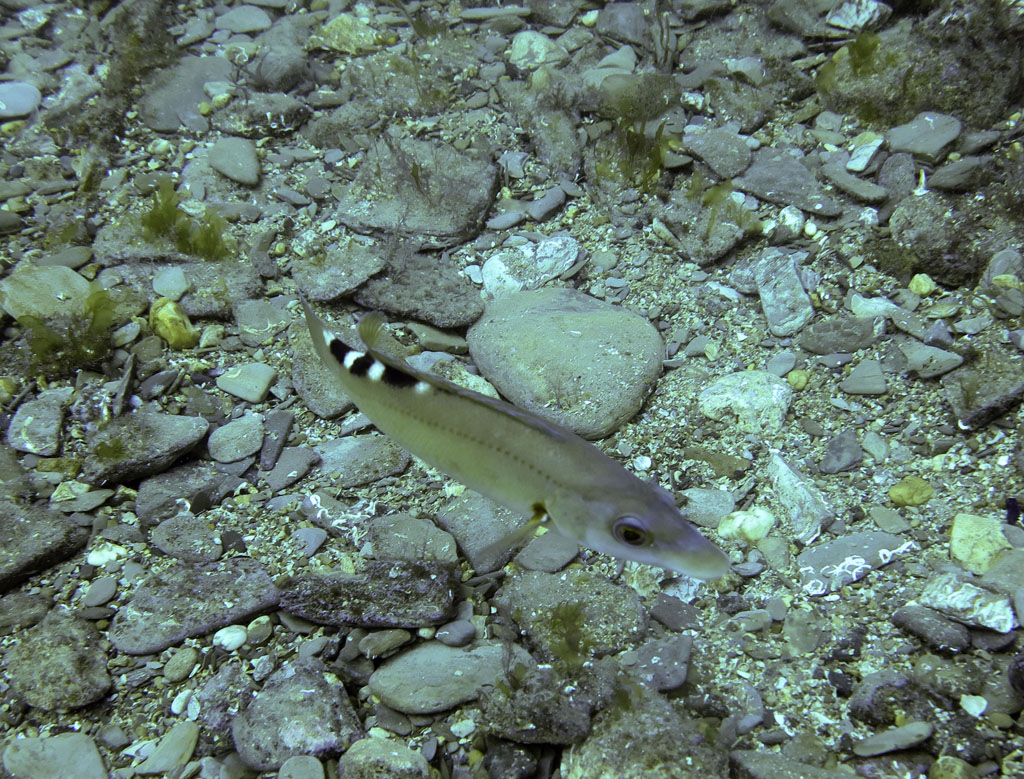
Cuckoo Wrasse
The sighting of a Sunfish and some Dolphins (briefly) added a bit more excitement to the journeys back from the sites and Venture (and the crew) proved the perfect way to dive Plymouth Sound once again.
The Moorings is probably the perfect place to stay for divers (just a shame on street parking prices have got so dear, but that's not their fault!), with a very friendly welcome, great breakfasts and a packed lunch for a bargain price.
Speaking personally, I'll certainly be putting my name down for future trips back to Plymouth.
Portland, July 2017
Somehow I got cashiered into arranging a second weekend in Portland.
This time, I decided we should try and be a bit more adventurous and explore some of the wreck sites, supposedly in the area.
The weather was kind again and 5 of us arrived at the boatyard ready to visit the supposed site of the British Inventor.
We had 2 sets of marks for the wreck, but neither showed a wreck on the plotter's chart.
We decided to give it a go anyway, but I'd misjudged the strength of the current and, even if we were on the wreck, we were immediately off on a drift dive.
There's not a lot to see drifting across Weymouth bay, but we found we were in the midst of an incredibly active Scallop bed. It seemed to be raining Scallops as we drifted along, except they were mainly going up as we approached!
I dived with Dawn and Dave and we also spotted an unexploded shell (maybe just a test one, but we decided not to poke it to find out!) that presumably had lain there for decades. We also saw a reasonably sized Dogfish at one point. It wasn't a thrilling dive and it was disappointing not to find any sign of the British Inventor, but it wasn't unpleasant.
Diving in two waves, as we were without a dedicated cox, took a long time and we had a late lunch. We decided to dive a wreck within the harbour afterwards and returned to the Spaniard, which we'd tried to dive earlier in the year, but given up due to zero vis.
Thankfully, the vis on this trip was very reasonable and the Spaniard (Actually called The Enecuri) revealed itself as a delightful wreck!
UPDATE: Further investigations suggests we might have actually been diving on a different wreck, next to the Spaniard, called the "Cragside"!
Short video from Portland, mostly the Spaniard wreck
Dropping down a buoy attached to the wreck, we found ourselves on the stern. Here were saw the ship was laying at about 45 degrees on her starboard side, with a stern rail and decking, with hatches open.
Moving forward over the stern, it dropped to the now collapsed (perhaps salvaged) deck, but we could look back inside the stern superstructure, where light flooded in through holes.
As we swam forward we found less and less of the ship, but the others had said to carry on and we soon came to more ribs and then onto the bow structure which was pretty intact (as you can see in the video).
We swam on a little, but there was nothing much there except some cable, so we turned around and swam back along the lower, starboard side, past a large group of fish and then back to the stern.
Before ascending the shotline, we swam up onto the port side and took in the rudder and large propellor.
We surfaced after a safety stop and then motored back to Ferry Bridge.
By now it was quite late and after dekitting and sorting out the boat, we needed to head off to the campsite to pitch my tent and claim a spot for Dave's van.
By the time we'd showered and headed back down to Casteltown we'd just missed last orders for food at all the pubs we tried.
We ended up having a couple of beers at the pub overlooking Chesil Beach and then headed back to the campsite, via a little Tescos for a meal deal - At least it was a cheap dinner!
Over our beers, Dave and I had decided we'd both elect to miss a dive on Sunday to mean we only needed one wave of divers.
Dave suggested diving the Bombardon Unit and Landing Craft again, whilst I wanted to try and find the wreck of the Earl Of Abergavenny, which supposedly lies just outside the north harbour entrance, a little deeper than the other site, so I dived first whilst Dave drove the boat.
I say it's supposedly there because we never saw any sign of anything at all. This was probably the most boring dive I've ever had.
At 15 minutes, I seriously considered surfacing, but persevered to 20 minutes to call it a 'dive'. We saw a few tiny gobies sticking their heads out of holes in the seabed and a solitary hermit crab, but that was it, no other fish, no rocks, no kelp, no crabs and most certainly no wreck.
Jane and I surfaced (She was very underwhelmed), but there was no sign of Dave and the boat! We weren't that far from the shotline we'd dropped in, but we couldn't see him anywhere.
I wasn't too worried, vis was great and the sea millpond flat, and after a few moments we spotted him a good half a mile away! He said he'd followed bubbles, but as Paul and Emma surfaced not far from us, we have no idea who or what he was following!
We lunched (and Paul and Emma refilled with air, while Jane headed home for a musical event) at Castletown and then set off for the harbour wall and the Bombardon Unit.
There was some discussion on the exact location and as we relocated to check what lay under the co-ordinates from the internet, the boat just stopped dead.
We suspected a few things, but nothing seemed awry, but the boat steadfastly refused to restart.
Our Sea-Start service couldn't tow us into Ferrybridge (too shallow apparently), but suggested we may have water in the fuel (Which I later found out had caused an identical stoppage the previous season). We didn't fancy paying to have the boat stored at Weymouth and in the end the Harbourmaster towed us into Ferrybridge (A fee is due for the service, but no doubt cheaper than a couple of weeks storage at a Weymouth site!).
So a mixed weekend. Our attempts to find new wrecks had been unsuccessful, but we'd found that the Enecuri was a great little wreck. The weather had been great, but a second enjoyable dive was scuppered by a breakdown.
The next action was to resolve the problem with the boat, so diving was put on hold for a few weeks, not helped by the keys being at John's house while he was on holiday!
Paul, Julian and I heaeded back to Portland a few weeks later, with some equipment and tools and swapped the fuel/water filter for a new one. Sadly with no positive effect on the starting of the engine.
After a few tries we called upon the Sea-Start service to come and take a look. He put the engine onto a PC to analyse the ECU and reported that the ECU signal was dropping whilst cranking. We looked at the plugs and he reported that they were probably shorting down their outside and that this may well be causing the ECU signal to drop. He had no spares, so we cleaned the ones in the engine up and, whilst it still wouldn't run properly, it did fire enough to run some fresh water through the engine.
After that we gave up for the day and decided to return when we'd obtained some replacement plugs.
Swanage, August 2017
With the boat out of action, I canvassed interest in a weekend diving from the Shuttles out of Swanage.
The plan was to dive the Saturday on wrecks above 20M for some of our Ocean Divers and then do a couple of deeper wrecks for Sports Divers and above.
Perhaps due to the time of year (Mid August), interest was low, with only Dawn and Ria joining me on the Saturday.
Ria and I met early on Saturday morning to travel out to Poole Bay to dive on a couple of amphibious Valentine Tanks that sank in trials prior to D-Day.
I'd heard that vis could be terrible here and that the tanks were badly eroded, but on the day we had 5-7M vis, enough to see both tanks in their entirity from any point.
We explored the first tank, which still has its turret attached and was very clearly a tank (If you're familiar with the Valentine tank, it's also pretty apparent that it is one of that type, but not everyone will be - I had to look the tank up on the Tank Museum website).
There was a conger hiding in the tank and a large shoal of Bib around it.
I didn't take my camera on this dive, but someone filmed this
video around the same time, which gives a good idea of the conditions - In fact I think it's the same dive and that's me at 1:09!
We followed the rope from the rear of the tank off to the second tank. As warned it seems too far, but we persevered and find the turret of the second tank upside down on the seabed, with the body of the tank, with many plates missing, exposing some of the workings and interior, a few metres (and clearly visible again) away.
After a while we headed back to the first tank and surfaced.
Later on in the morning, Dawn arrived and we all boarded Mary Jo again to travel out to the wreck of the Fleur De Lys.
On the way out we were informed that there was now a barge sunk a little way away from the wreck of the crumbling wooden fishing boat, linked to it by a guide rope.
As we descended the shotline, it was clear that there was a not inconsiderable amount of current running...
It proved a bit of a challenge to stay together as a 3 and on the wreck, but Dawn and Ria, still quite inexperienced divers, impressed by managing it!
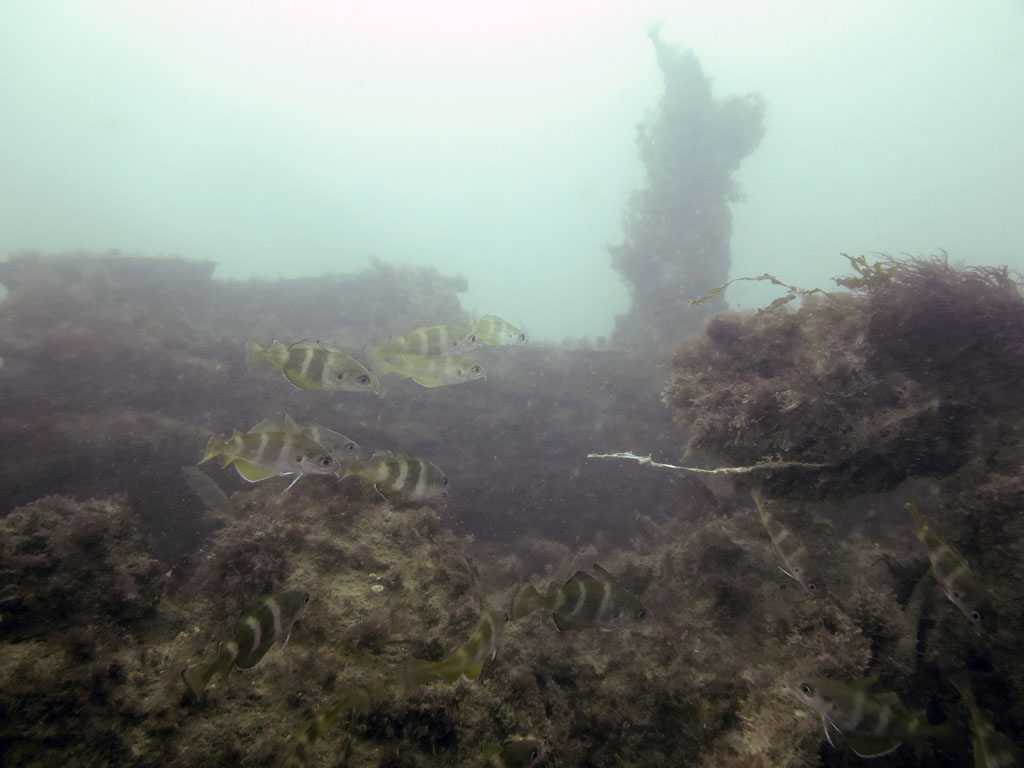
Bib on most dives, here on the Fleur De Lys
We explored the quite small wreck, picking out life and taking in the shoals of Bib and avoiding the exposed nails that threatened to spoil our dive with a torn dry suit!
As I was about to give up hope of finding the guide rope, I spotted it and we swam into the current to the barge, which surprised by being quite large with a hold area about the size of a tennis court, where we could drop out of the current and look for life. We spotted a couple of crabs and a few Tompot Blennies.
After a while, we let the current drift us back off the barge and along the rope to the Fleur De Lys and after a short final look around we surfaced after a 43 minute dive.
Ria headed home after this dive, but Dawn and I decided to squeeze in a dive under the pier.
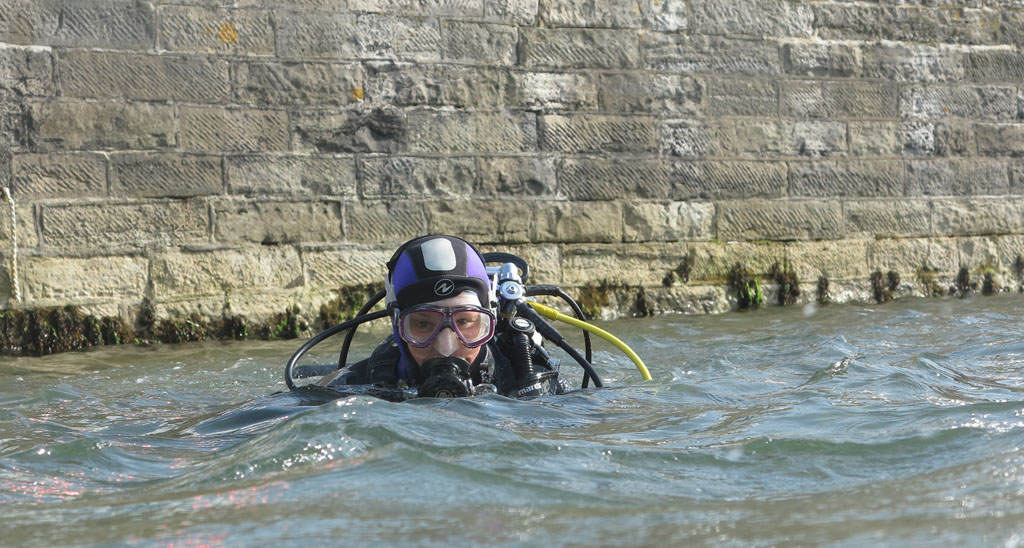
Dawn descends to explore the pier
I'm not really convinced of Swanage Pier as a great shore dive and the vis was cloudy again today, but there was, at least, plenty of life under there, including a couple of flatfish, which I think were Plaice.
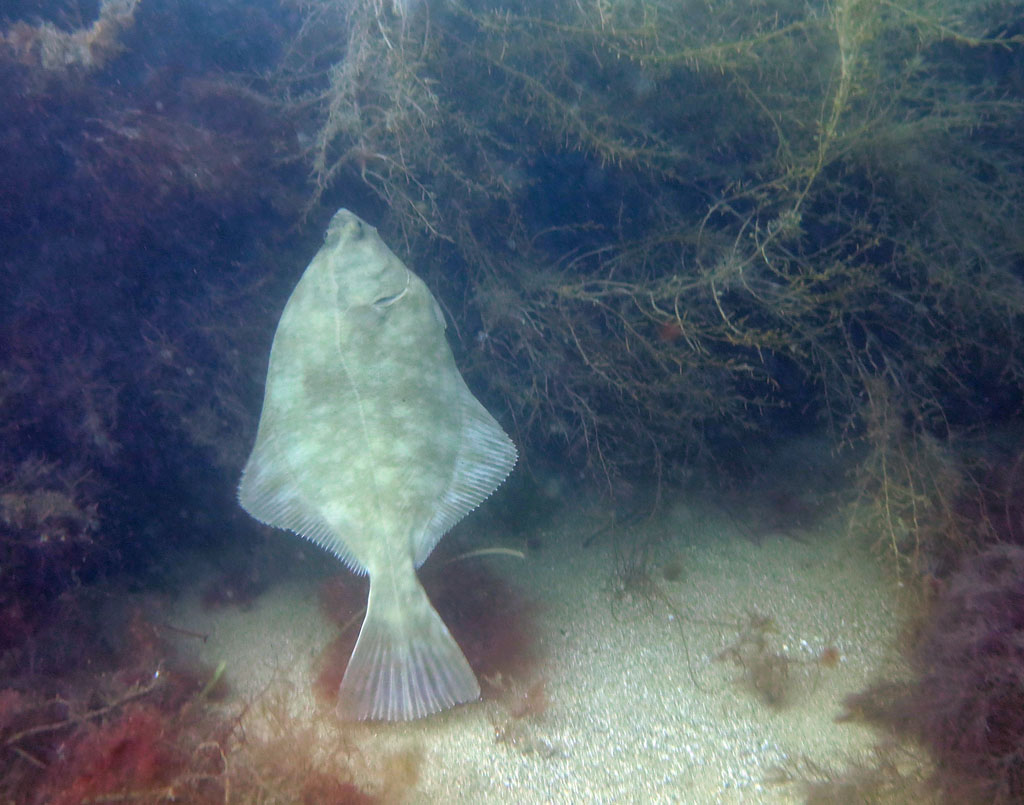
Plaice(?) under the pier
After about 30 minutes we called it a day and packed up, Dawn heading home, whilst I headed back to the campsite for a shower and then to look for something to do for the evening.
It turned out to be Swanage Lifeboat week and Saturday featured a BBQ and live bands all afternoon and into the late evening. By the time I arrived, a young group called Galaxy Thief were playing a mixture of indy covers and their own material. They were pretty good.
A strong local cider and a burger later, a group of middle aged people wandered onto the stage and were announced as 'local legends', The Reptiles (which meant nothing to me).
They started out doing 60s and 70s covers, pretty well, but didn't really strike me as remarkable, but as they light faded, more beer got drunk and they hit their stride, they really got the audience, me included, on their side and the 11 O'Clock curfew came too soon.
All in all, it had turned out to be a great evening!
I was, truth be told, a little cold in my tent overnight, so I was up around 6:15 and, after a quick wash, struck my tent and joined the queue for the Pier again.
With no-one from the club diving with me on the Sunday, I had to rely on strangers to allow me to join them, but it was no problem for most and I enjoyed both dives.
First up was a dive on the Kyarra.
I dived this with a couple of divers from North Dorset, one on a rebreather, the other, like me, with air in 15L cylinder.
Vis was good on the Kyarra, with huge shoals of Pollock and Bib, along with the odd Lobster and crab.
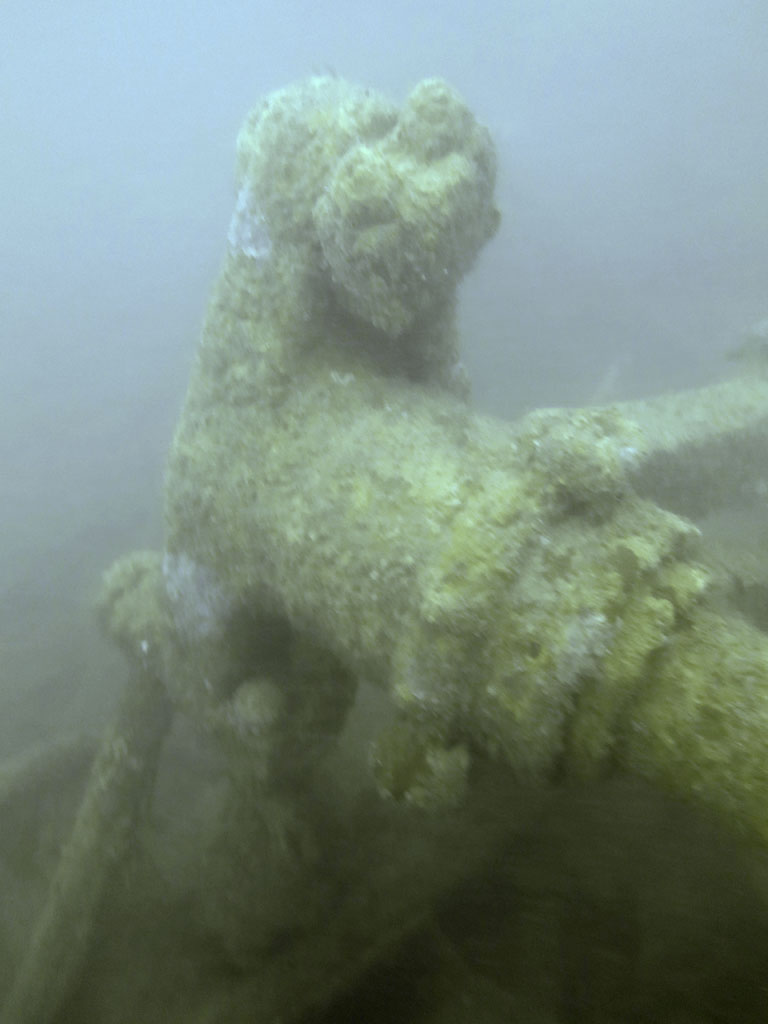
Steering gear on the Kyarra
The chap on the rebreather seemed to spend a fair amount of time, scrabbling around in the junk within the wreck, which baffled me until he suddenly was holding what looked like a bolt of fabric. He'd obviously hoped to find something as he had a lifting bag and dropped his find into it and sent it to the surface - I later found out that it was a bolt of Silk from the original cargo and, once dried, would be perfectly usable! I'll look more carefully next time I'm on the Kyarra!
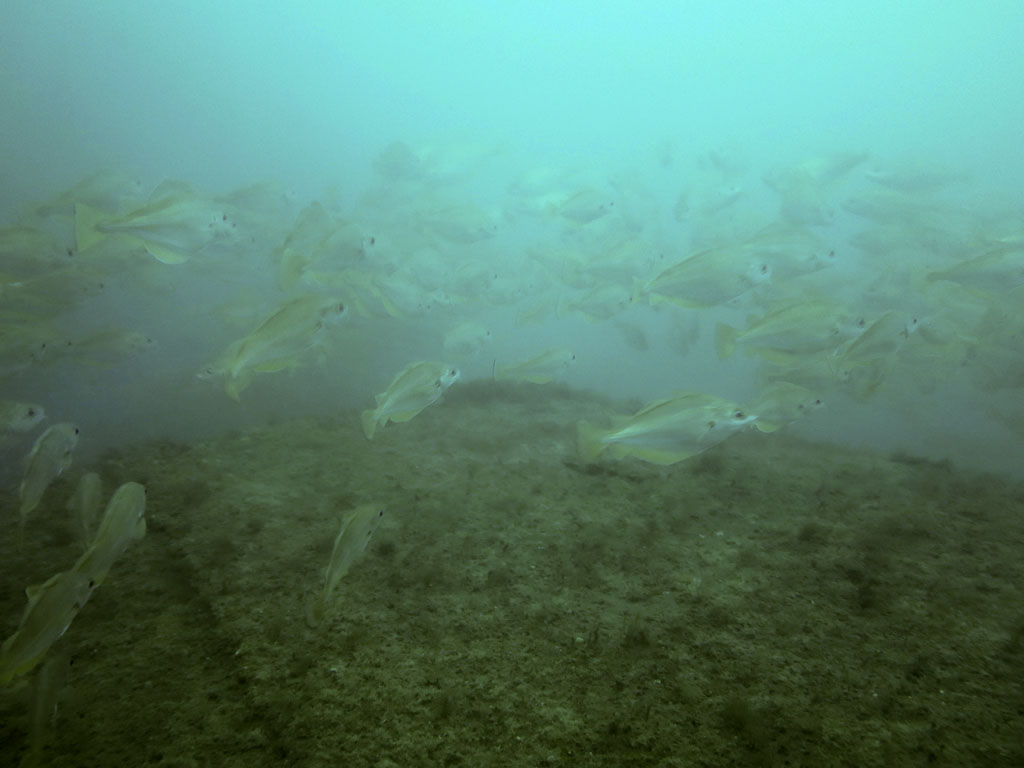
Pollock(?) on the Kyarra
At one point, John (the OC diver) was peering into a hole and I was 3 or so metres above him when I spotted a grey shape move off to our left. I focused on it and at first thought it was a shark, but it quickly became clear that it was a Conger swimming in open water, something I'd never seen before! Amazingly, it swam within a foot of John's head into the hole he was looking, but he didn't see it!
We had a long dive on the Kyarra and incurred a little deco (John's computer was set for a deep stop, so we did a minute a 9 metres and 4 at 6), but it had been a great dive!
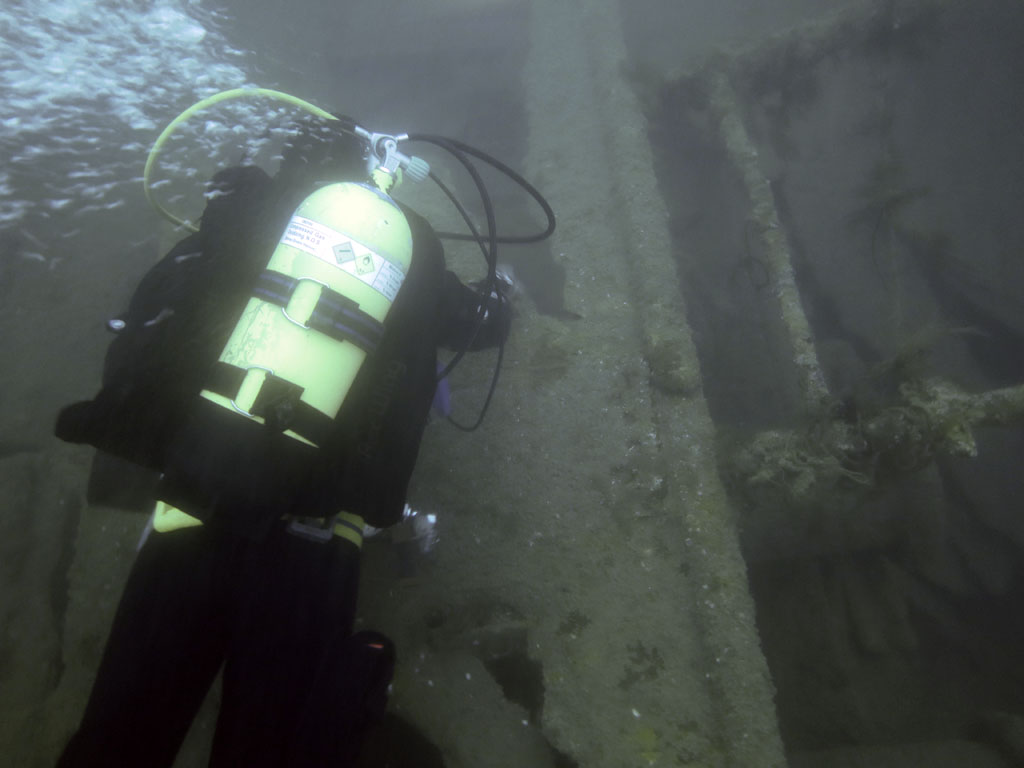
John explores the Kyarra's hull. The ship is on it's side, ridge to his right is the deck with a railing attached
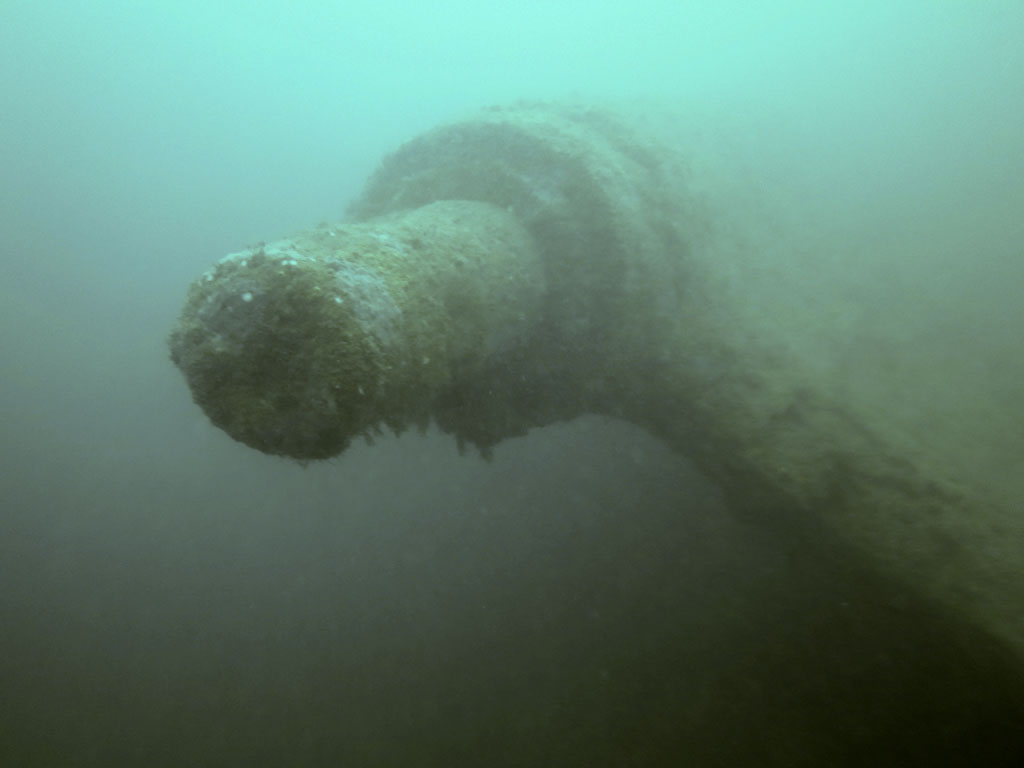
Kyarra's drive shaft where the propellor once sat
I had a long wait (until 3:30 PM) before my second dive, on the Carentan, a French Submarine 'Chasseur' that I'd never dived on before, so I ate my lunch, read a magazine and caught a little sleep to make up for the rather disturbed and short night's sleep before.
Eventually, the time rolled 'round and I reboarded Mary Jo to go to the Carentan. There were only 3 of us, myself and a couple from London, so we dived together.
The couple know the wreck well, so the skipper gave me a quick overview of the wreck, including things to look for, such as the Sonar 'ear' under the keel, the AA gun, depth charges and the engines.
We dropped onto the wreck to find visibility pretty good again (5-7M, I'd guess) and managed to get around it within the 20M no-deco time the others had.
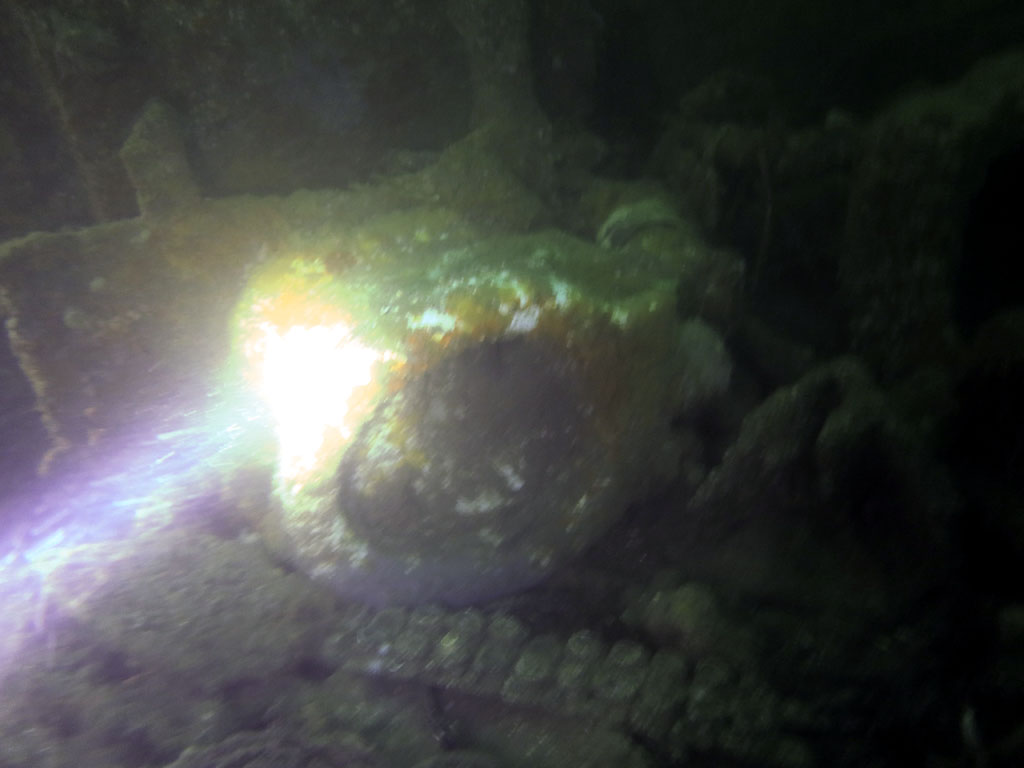
Intact toilet on the Carentan.
I spotted the Sonar 'ear' (Without the skipper's briefing I wouldn't have known what it was!) and boxes of ammunition for the long gone machine guns. There's also the remains of a bathroom, with a toilet bowl and sink, on the wreck, as well as the engines and the substantial AA gun, although it's starting to form into one solid lump of rust now, so you need to look carefully to tell the elevation gears from the breech and barrel.
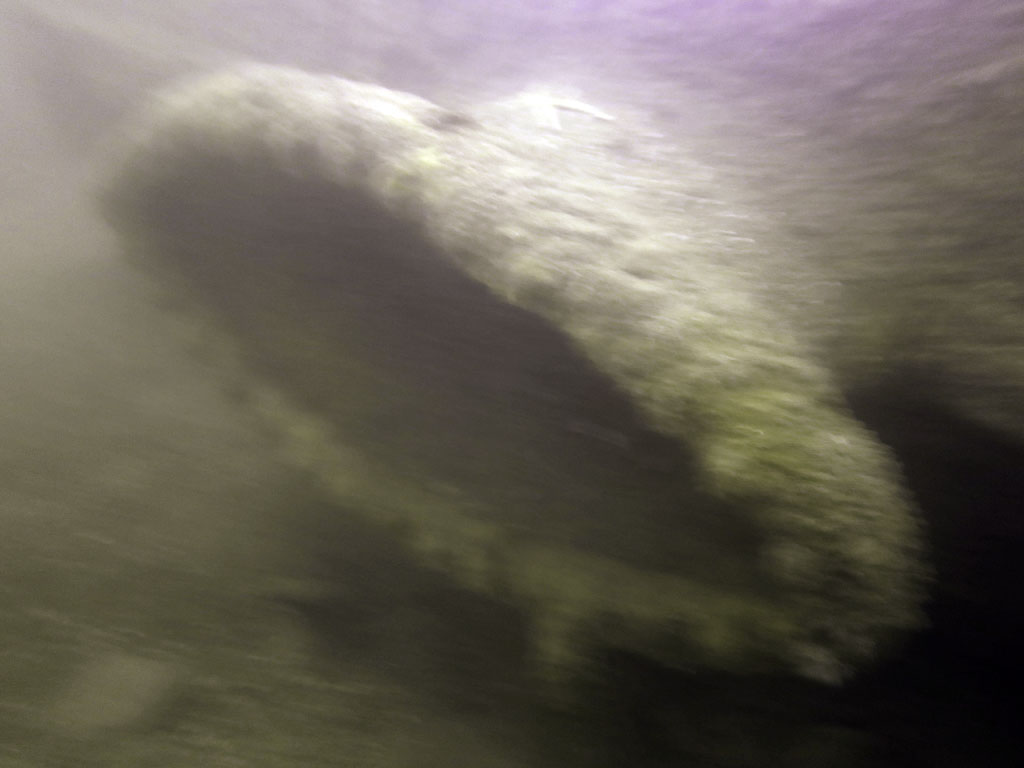
The Carentan's sonar 'ear' on the keel.
My computer is a little more generous with time, so I stayed a minute or two more, looking at the AA gun in some more detail, before taking the shotline up, expecting to find the others still there.
I was a bit surprised to not find them and having completed my safety stop, found the end of the shot was now 2M under water! Fortunately the skipper spotted me from some distance away (where I could see a DSMB up) and came and picked me up before the others. It turned out they remembered the shot would be underwater and so went up on a DSMB!
Anyway, all was well and the Carentan is certainly a wreck worth diving again.
All in all, it had been a great weekend for me, but a disappointment that more people hadn't come and enjoyed it too.
A couple of dives, assisting with training for Sports Diver students, followed at Wraysbury, but one of the highlights of my diving year was to follow in September.
Read some more of my diving experiences, by clicking the icons below.


